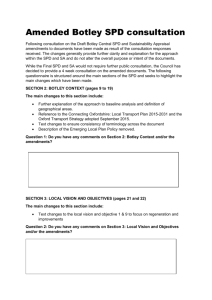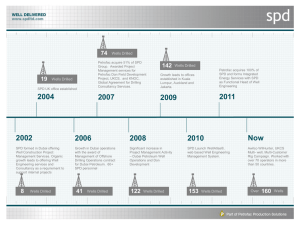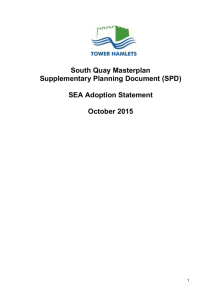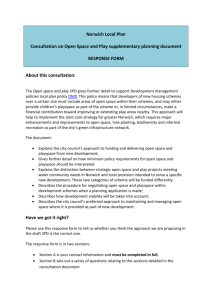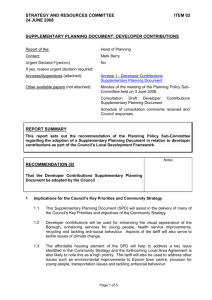Summary - Meetings
advertisement
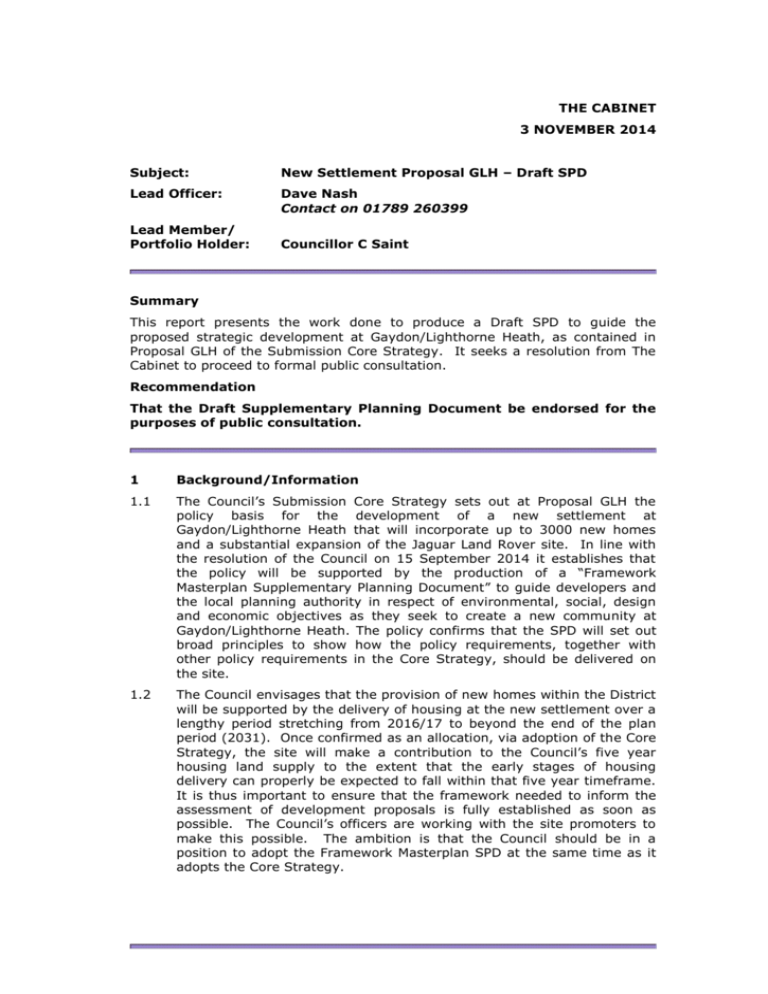
THE CABINET 3 NOVEMBER 2014 Subject: New Settlement Proposal GLH – Draft SPD Lead Officer: Dave Nash Contact on 01789 260399 Lead Member/ Portfolio Holder: Councillor C Saint Summary This report presents the work done to produce a Draft SPD to guide the proposed strategic development at Gaydon/Lighthorne Heath, as contained in Proposal GLH of the Submission Core Strategy. It seeks a resolution from The Cabinet to proceed to formal public consultation. Recommendation That the Draft Supplementary Planning Document be endorsed for the purposes of public consultation. 1 Background/Information 1.1 The Council’s Submission Core Strategy sets out at Proposal GLH the policy basis for the development of a new settlement at Gaydon/Lighthorne Heath that will incorporate up to 3000 new homes and a substantial expansion of the Jaguar Land Rover site. In line with the resolution of the Council on 15 September 2014 it establishes that the policy will be supported by the production of a “Framework Masterplan Supplementary Planning Document” to guide developers and the local planning authority in respect of environmental, social, design and economic objectives as they seek to create a new community at Gaydon/Lighthorne Heath. The policy confirms that the SPD will set out broad principles to show how the policy requirements, together with other policy requirements in the Core Strategy, should be delivered on the site. 1.2 The Council envisages that the provision of new homes within the District will be supported by the delivery of housing at the new settlement over a lengthy period stretching from 2016/17 to beyond the end of the plan period (2031). Once confirmed as an allocation, via adoption of the Core Strategy, the site will make a contribution to the Council’s five year housing land supply to the extent that the early stages of housing delivery can properly be expected to fall within that five year timeframe. It is thus important to ensure that the framework needed to inform the assessment of development proposals is fully established as soon as possible. The Council’s officers are working with the site promoters to make this possible. The ambition is that the Council should be in a position to adopt the Framework Masterplan SPD at the same time as it adopts the Core Strategy. 1.3 The 2012 Regulations require that before a local planning authority adopts a supplementary planning document it must prepare a statement setting out the persons it consulted when preparing the SPD, a summary of the main issues raised by those persons, and a summary of the way those issues have been addressed in the SPD. Consultation on the Draft SPD is thus a legal imperative as well as a necessary way of ensuring that local perspectives are taken into account. At this stage the proposal is to move to informal consultation to ensure appropriate engagement of local communities and stakeholders in the preparation of the SPD, as required by the Council’s Statement of Community Involvement. A second more formal period of consultation will take place in due course, as required by the Development Plan Regulations. 1.4 Arrangements to promote collaborative work on the development of Proposal GLH have been in place since November 2013. Prior to the Council’s decision to include Proposal GLH in its Proposed Submission Core Strategy (May 2014), this collaboration proceeded entirely on a no commitment basis and with a remit to ensure that, if GLH emerged as the preferred strategic option, the associated policy would promote the best possible form of development for the site. Within this context work relevant to the preparation of the Draft SPD has been ongoing since the formation of a Steering Group in February 2014 and has now reached the stage where a draft document considered to form a proper basis for wider consultation can be presented. 1.5 Members will see that the new settlement has been given the working title of “Kingston Grange”, reflecting the name of the farmstead located in the central part of the site. This idea has emerged from the local engagement process but should not be regarded as pre-determining consideration of an appropriate name for the new settlement. That is a matter upon which a Council decision will be required in due course, informed by a more comprehensive consultation exercise. 2 Overview of the content of the Draft SPD 2.1 Following a brief introductory section, the document presents an analysis of the site and its context. It describes the general location in which the site fits, including the availability of local services and facilities. It also sets out the planning policy context. There is then a detailed analysis of the site constraints and opportunities that have a bearing on the way in which development proposals should be formulated. The analysis considers topography and views, landscape character, soil and ground conditions/contamination, access and movement, heritage, ecology, flood risk and drainage, utilities, noise and air quality. 2.2 The stakeholder and community engagement undertaken to date is then summarised. This section of the document includes reference to the Steering Group referred to above, and also to the working groups that were established to consider in greater detail matters such as the green infrastructure strategy, transport and community infrastructure. Key technical partners have been engaged in these working groups. A workshop session was held in late June to engage with a wide range of local stakeholders. Following this a community exhibition was held at Lighthorne Heath School in early July to provide local people with an opportunity to comment on the emerging proposals. 2.3 The SPD then moves on to translate the information derived from the process of survey and analysis into a vision and set of principles to inform the development of the overall site. These include reference to the nature and location of the new village centre, the mix and design of homes, connectivity, character/identity and urban form, and sense of place. The principles include matters such as sustainability, biodiversity, delivery and long term management, and on-going community engagement. 2.4 All this information builds into the presentation of a Concept Masterplan for the new settlement. This is derived from the place-making principles, which themselves respond to the site’s natural features and the initial engagement with stakeholders. The key components of the masterplan are as follows: The Jaguar Land Rover expansion site is located to the south of Gaydon Coppice; Land to the west of Banbury Road (B4100), with the exception of housing to the immediate north of Lighthorne Heath, remains open and is devoted to use as a managed nature reserve and sports pitch provision; Development is set back from the areas of ancient woodland; A landscaped bank is established along the boundary with the M40 to mitigate any noise or air quality impacts on the new development (and on Lighthorne Heath); An area of public open space is created between the new dual carriageway (Junction 12 to JLR site entrance) and the village of Gaydon; Existing woodlands, hedges and watercourses are incorporated into a green infrastructure framework providing a structure for the new village and the Jaguar Land Rover expansion; The development uses a sustainable urban drainage system approach including retention basins with attractive planting to encourage biodiversity within the green infrastructure; Kingston Grange Farm is retained and converted to accommodate new uses; A new mixed use village centre is provided to serve the existing and new living and working communities; this will include a village square, primary school, community hub incorporating meeting space and health centre, a food store and range of other shops/restaurants, offices, homes (including specialised accommodation for the elderly) and possibly a hotel; The new village centre is located close to Lighthorne Heath and the B4100 will be adapted to reduce traffic speeds and promote integration between existing and new areas of development; The residential neighbourhoods will be set within the green infrastructure and will provide a range of different types, sizes and tenures of housing, including affordable homes. 2.5 The masterplan then considers in more detail the identification of seven character areas within the new settlement. It proposes a range of densities, building types, building heights and materials that would make each character area distinctive. The recommended approach reflects the desire to create a high quality contemporary settlement rather than a pastiche Warwickshire village. The suggested use of stone, brick and render picks up on local built character, but is accompanied by proposals that encourage more contemporary designs using glass, metal cladding and green roofs in some parts of the settlement. The more contemporary approaches would be employed principally around the village centre and in the more southerly parts of the settlement having a visual relationship with the JLR site. 2.6 The SPD will establish a sustainability framework for the new settlement. It is acknowledged that the development represents a significant opportunity to design in measures to mitigate and deal with the effects of climate change and to deliver innovative and integrated sustainable solutions. It points to the opportunity to utilise innovative local approaches to heating and cooling, including decentralised energy systems, across both the residential and commercial areas of the settlement. 3 Options available to The Cabinet 3.1 The following options are available: To accept the draft document as representing a suitable basis for consultation; To agree amendments to the draft document that would make it acceptable for the purposes of consultation; or To defer moving to consultation pending the introduction of more substantive changes to the draft document. 4 Implications of the Proposal 4.1 Legal/Human Rights Implications 4.1.1 Once adopted the document will provide guidance to applicants seeking permission to implement different aspects of the overall development. The document has to be prepared in accordance with the requirements of the Town and Country Planning (Local Development) (England) Regulations 2012 and of the Council’s Statement of Community Involvement (updated February 2014). 4.2 Financial 4.2.1 The direct financial implications are restricted to costs associated with the publication of the draft SPD and the holding of any consultative events. These costs will be met from existing budgets. 4.3 Environmental 4.3.1 The SPD is important in establishing a framework to deliver an environmentally sustainable form of development. 4.4 Corporate Strategy 4.4.1 The production of the SPD supports the four aims of the Corporate Strategy, to address local housing need, to help business and enterprise flourish in the district, to improve access to services and to minimise the impacts of climate change. 4.5 Analysis of the Effects on Equality 4.5.1 None identified. 5 Risk Assessment 5.1 On the assumption that Proposal GLH is retained in its adopted Core Strategy, the Council should ensure that the development can commence in a timely fashion. This is especially relevant to the residential aspects of the development, as the housing trajectory in the Core Strategy envisages that new homes on the site will start to become available in 2016/17, contributing to the Council’s five year supply of housing land. Given that its purpose is to provide guidance to prospective applicants, a failure to progress the SPD could risk the timely delivery of development and create pressures to release alternative sites to ensure that a sufficient supply of housing land is maintained. 6 Conclusion 6.1 Work on the preparation of the draft SPD has now progressed to the point where the document is considered suitable for consultation. The Council is committed via its Statement of Community Involvement to ensuring that local communities can make a contribution to the preparation of an SPD at an appropriately early stage. The Cabinet is thus requested to endorse the draft document for the purpose of public consultation. Paul Lankester CHIEF EXECUTIVE Background papers: Stratford-on-Avon District Core Strategy Proposed Submission Version (July 2014) Schedule of Proposed Minor Modifications to the Core Strategy (September 2014)


